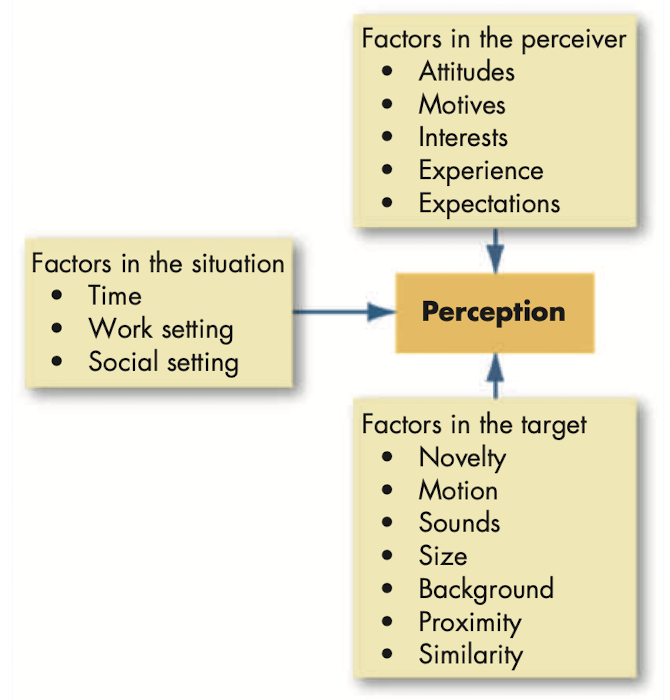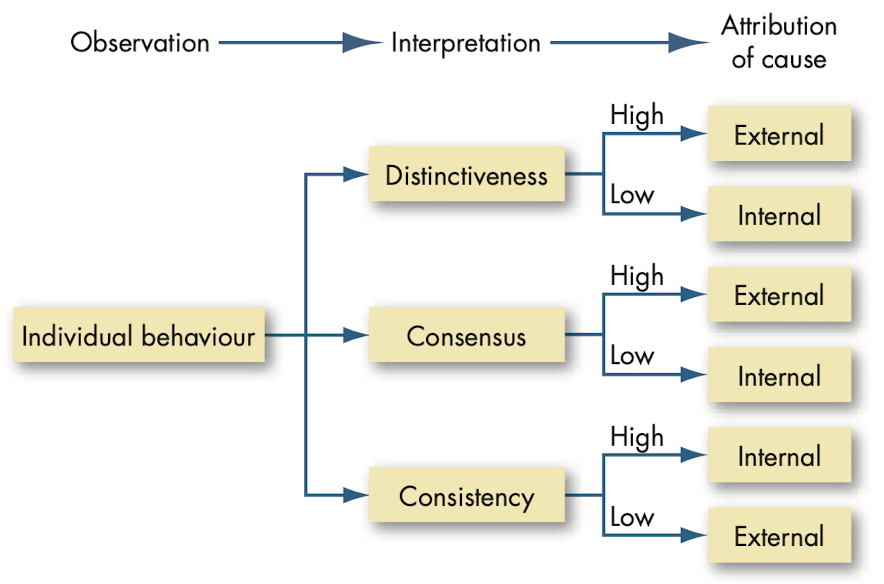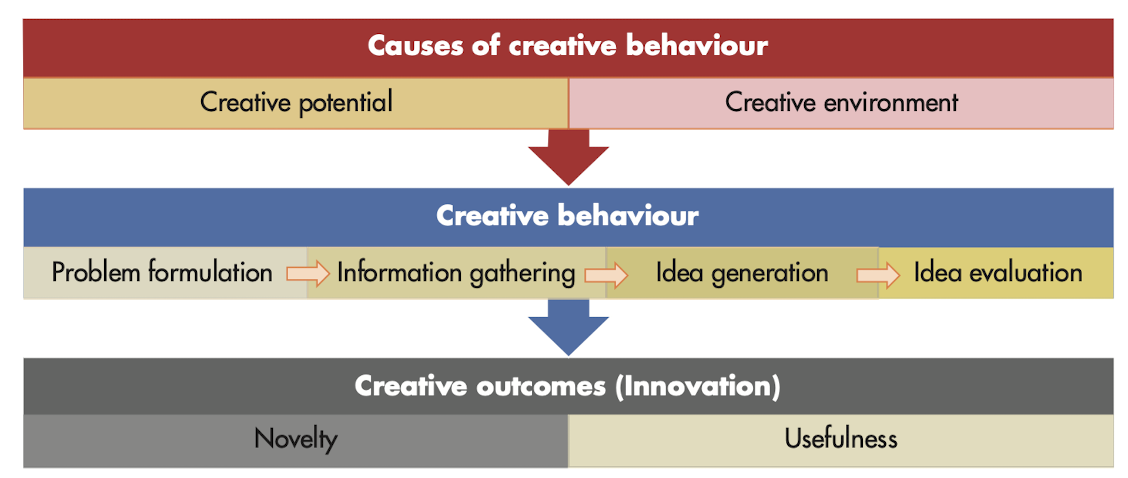
Chapter 5 - Perception, individual decision making & creativity
What is perception?
Perception: process by which individuals organize and interpret their sensory impressions in order to give meaning to their environment.

Person perception: making judgements about others
Attribution theory: attempt to determine whether an individual’s behavior is internally or externally caused.

Fundamental attribution theory: tendency to underestimate the influence of external factors and overestimate the influence of internal factors when making judgements about the behavior of others.
Self-serving bias: tendency for individuals to attribute their own success to internal factors and put the blame for failures on external factors.
Frequently used shortcuts in judging others
Selective perception: tendency to selectively interpret what one sees on the basis of one's interests, background, experience and attitudes.
Halo effect: tendency to draw a general impression about an individual on the basis of a single characteristic.
Contrast effects: evaluation of a person’s characteristics that is affected by comparisons with other people recently encountered who rank higher or lower on the same characteristics.
Stereotyping: judging someone on the basis of one’s perception of the group to which that person belongs.
Specific applications of shortcuts in organizations
Employment interview → perceptual judgements are made that are often inaccurate.
Performance expectations → if a manager expects great things from her workers, they are likely to meet their expectations.
Self-fulfilling prophecy: situation in which a person inaccurately perceives a second person and the resulting expectations cause the second person to behave in ways consistent with the original perception.
Performance evaluation can be problematic because many shortcuts and subjectiveness is used.
The link between perception and individual decision-making
Decisions: choices from among to or more alternatives.
Problem: discrepancy between the current state of affairs and some desired state.
Decision making in organizations
Rational decision making
Rational: characterized by making consistent, value maximizing choices within specified constraints.
Rational decision making model: decision making model that describes how individuals should behave in order to maximize some outcome.
Define the problem
Identify the decision criteria
Allocate weights to the criteria
Develop the alternatives
Evaluate the alternatives
Select the best alternative
Bounded rationality: process of making decisions by constructing simplified models that extract the essential features from problems without capturing all their complexity.
Intuitive decision making: unconscious process created out of distilled experience.
Common biases and errors in decision making
Overconfidence bias: overconfident about our abilities and the abilities of others, usually unaware of it.
Anchoring bias: tendency to fixate on initial information, from which one then fails to adequately adjust for subsequent information.
Confirmation bias: tendency to seek out information that reaffirms past choices and to discount information that contradicts past judgements.
Availability bias: tendency for people to base their judgements on information that is readily available to them.
Escalation of commitment: increased commitment to a previous decision in spite of negative information.
Randomness error: tendency of individuals to believe that they can predict the outcome of random events.
Risk aversion: tendency to prefer a sure gain of a moderate amount over a riskier outcome might have a higher expected payoff.
Hindsight bias: tendency to believe falsely, after an outcome of an event is actually known, that one would have accurately predicted the outcome.
Influences on decision making: individual differences and organizational constraints
Individual differences
Personality → personality influences our decisions.
Gender → women tend to spend more time than men analyzing decisions.
Mental ability → people with higher levels of mental ability are able to process information more quickly and solve problems more accurately.
Cultural differences → cultural background can definitely influence the way a decision is being made like in the selection of problems, depth of the analysis, etc.
Organization constraints
Performance evaluation → managers are strongly influenced in their decision making by the criteria on which they are evaluated.
Reward systems influences decision makers by suggesting to them what choices are preferable in terms of personal payoff.
Formal regulations → rules that are set and need to be followed are definitely a constraint in the decisions that can or can not be taken.
System-imposed time constraints → decisions are often imposed with deadlines, they need to be made before a certain date.
Historical precedents → choices made today are therefore a result of choices made over the years.
What about ethics in decision making?
3 ethical decision criteria
Utilitarian criterion: system in which decisions are made to provide the greatest good for the greatest number.
Rights criterion: individuals to make decisions consistent with fundamental liberties and privileges, respecting and protecting basic rights of every individual.
Whistle-blowers: individuals who report unethical practices by their employer to outsiders.
Justice criterion: impose and enforce rules fairly and impartially so that there is an equitable distribution of benefits and costs.
Behavioral ethics: analyzing how people actually behave when confronted with ethical dilemmas.
Creativity, decision making and innovation in organizations
Creativity: ability to produce novel and useful ideas.
Three-stage model of creativity: proposition that involves three stages: causes (creative potential and creative environment), creative behavior and creative outcomes (innovation).
Creative behavior
Problem formulation: state of creative behavior which involved identifying problem or opportunity that requires a solution that is as yet unknown.
Information gathering: state when possible solutions to a problem incubate in individuals mind.
Idea generation: process of creative behavior that involves developing possible solutions to a problem from relevant information and knowledge.
Idea evaluation: process of creative behavior involving the evaluation of potential solutions to problems to identify the best one.
Causes of creative behavior
Creative potential: intelligence is related to creative behavior, expertise is the foundation of all creative work.
Creative environment: potential is not enough, you need to be in an environment where creative potential can be realized.
Creative outcomes (innovation): ideas or solutions judged to be novel and useful by relevant stakeholders.

Chapter 5 - Perception, individual decision making & creativity
What is perception?
Perception: process by which individuals organize and interpret their sensory impressions in order to give meaning to their environment.

Person perception: making judgements about others
Attribution theory: attempt to determine whether an individual’s behavior is internally or externally caused.

Fundamental attribution theory: tendency to underestimate the influence of external factors and overestimate the influence of internal factors when making judgements about the behavior of others.
Self-serving bias: tendency for individuals to attribute their own success to internal factors and put the blame for failures on external factors.
Frequently used shortcuts in judging others
Selective perception: tendency to selectively interpret what one sees on the basis of one's interests, background, experience and attitudes.
Halo effect: tendency to draw a general impression about an individual on the basis of a single characteristic.
Contrast effects: evaluation of a person’s characteristics that is affected by comparisons with other people recently encountered who rank higher or lower on the same characteristics.
Stereotyping: judging someone on the basis of one’s perception of the group to which that person belongs.
Specific applications of shortcuts in organizations
Employment interview → perceptual judgements are made that are often inaccurate.
Performance expectations → if a manager expects great things from her workers, they are likely to meet their expectations.
Self-fulfilling prophecy: situation in which a person inaccurately perceives a second person and the resulting expectations cause the second person to behave in ways consistent with the original perception.
Performance evaluation can be problematic because many shortcuts and subjectiveness is used.
The link between perception and individual decision-making
Decisions: choices from among to or more alternatives.
Problem: discrepancy between the current state of affairs and some desired state.
Decision making in organizations
Rational decision making
Rational: characterized by making consistent, value maximizing choices within specified constraints.
Rational decision making model: decision making model that describes how individuals should behave in order to maximize some outcome.
Define the problem
Identify the decision criteria
Allocate weights to the criteria
Develop the alternatives
Evaluate the alternatives
Select the best alternative
Bounded rationality: process of making decisions by constructing simplified models that extract the essential features from problems without capturing all their complexity.
Intuitive decision making: unconscious process created out of distilled experience.
Common biases and errors in decision making
Overconfidence bias: overconfident about our abilities and the abilities of others, usually unaware of it.
Anchoring bias: tendency to fixate on initial information, from which one then fails to adequately adjust for subsequent information.
Confirmation bias: tendency to seek out information that reaffirms past choices and to discount information that contradicts past judgements.
Availability bias: tendency for people to base their judgements on information that is readily available to them.
Escalation of commitment: increased commitment to a previous decision in spite of negative information.
Randomness error: tendency of individuals to believe that they can predict the outcome of random events.
Risk aversion: tendency to prefer a sure gain of a moderate amount over a riskier outcome might have a higher expected payoff.
Hindsight bias: tendency to believe falsely, after an outcome of an event is actually known, that one would have accurately predicted the outcome.
Influences on decision making: individual differences and organizational constraints
Individual differences
Personality → personality influences our decisions.
Gender → women tend to spend more time than men analyzing decisions.
Mental ability → people with higher levels of mental ability are able to process information more quickly and solve problems more accurately.
Cultural differences → cultural background can definitely influence the way a decision is being made like in the selection of problems, depth of the analysis, etc.
Organization constraints
Performance evaluation → managers are strongly influenced in their decision making by the criteria on which they are evaluated.
Reward systems influences decision makers by suggesting to them what choices are preferable in terms of personal payoff.
Formal regulations → rules that are set and need to be followed are definitely a constraint in the decisions that can or can not be taken.
System-imposed time constraints → decisions are often imposed with deadlines, they need to be made before a certain date.
Historical precedents → choices made today are therefore a result of choices made over the years.
What about ethics in decision making?
3 ethical decision criteria
Utilitarian criterion: system in which decisions are made to provide the greatest good for the greatest number.
Rights criterion: individuals to make decisions consistent with fundamental liberties and privileges, respecting and protecting basic rights of every individual.
Whistle-blowers: individuals who report unethical practices by their employer to outsiders.
Justice criterion: impose and enforce rules fairly and impartially so that there is an equitable distribution of benefits and costs.
Behavioral ethics: analyzing how people actually behave when confronted with ethical dilemmas.
Creativity, decision making and innovation in organizations
Creativity: ability to produce novel and useful ideas.
Three-stage model of creativity: proposition that involves three stages: causes (creative potential and creative environment), creative behavior and creative outcomes (innovation).
Creative behavior
Problem formulation: state of creative behavior which involved identifying problem or opportunity that requires a solution that is as yet unknown.
Information gathering: state when possible solutions to a problem incubate in individuals mind.
Idea generation: process of creative behavior that involves developing possible solutions to a problem from relevant information and knowledge.
Idea evaluation: process of creative behavior involving the evaluation of potential solutions to problems to identify the best one.
Causes of creative behavior
Creative potential: intelligence is related to creative behavior, expertise is the foundation of all creative work.
Creative environment: potential is not enough, you need to be in an environment where creative potential can be realized.
Creative outcomes (innovation): ideas or solutions judged to be novel and useful by relevant stakeholders.

 Knowt
Knowt
